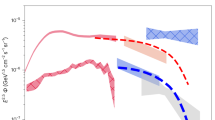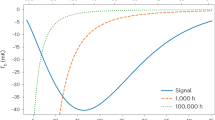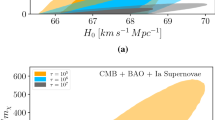Abstract
SCIAMA has argued1–4 that the dark matter associated with galaxies, clusters of galaxies and the intergalactic medium consists of τ neutrinos of rest mass 28–30 eV, whose decay generates ultraviolet photons of energy ∼mv/2≈14–15 eV. We have carried out a test of this hypothesis using the Hopkins Ultraviolet Telescope, which was flown aboard the space shuttle Columbia as part of the Astro-1 mission in December 1990. A straightforward application of Sciama's model predicts that we should have observed, from the rich galaxy cluster Abell 665, a spectral line from neutrino decay photons with a signal-to-noise ratio of ∼30. We detected no such emission. For neutrinos (or any similar dark matter particle) in the mass range 27.2–32.1 eV, our observations set a lower lifetime limit significantly greater than Sciama's model requires.
This is a preview of subscription content, access via your institution
Access options
Subscribe to this journal
Receive 51 print issues and online access
$199.00 per year
only $3.90 per issue
Buy this article
- Purchase on Springer Link
- Instant access to full article PDF
Prices may be subject to local taxes which are calculated during checkout
Similar content being viewed by others
References
Sciama, D. W. Astrophys. J. 364, 549–554 (1990).
Sciama, D. W. Phys. Rev. Lett. 65, 2839–2841 (1990).
Sciama, D. W. Nature 348, 617–618 (1990).
Sciama, D. W. Astrophys. J. 367, L39–L41 (1991).
Cowsik, R. Phys. Rev. Lett. 39, 784–787 (1977).
De Rujula, A. & Glashow, S. Phys. Rev. Lett. 45, 942–944 (1980).
Melott, A. L. & Sciama, D. W. Phys. Rev. Lett. 46, 1369–1371 (1981).
Pal, P. B. & Wolfenstein, L. Phys. Rev. D25, 766–773 (1982).
Maalampi, J. & Roos, M. Phys. Letters B229, 388–390 (1989).
Abell, G. O. Astrophys. J. Suppl. Ser. 3, 211 (1958).
Johnson, M. W., Crudace, R. G., Ulmer, M. P., Kowalski, M. P. & Wood, K. S. Astrophys. J. 266, 425–445 (1983).
Soltan, A. & Henry, J. P. Astrophys. J. 271, 442–445 (1983).
Oegerle, W., Fitchett, M. J., Hill, J. M. & Hintzen, P. Astrophys. J. (in the press).
Rood, H. J., Page, T. L. Kintner, E. C. & King, I. R. Astrophys. J. 175, 627–647 (1972).
Dressler, A. Astrophys. J. 226, 55–60 (1978).
Beers, T. C. & Tonry, J. L. Astrophys. J. 300, 557–567 (1986).
Avni, Y. Astrophys. J. 210, 642–646 (1976).
Burstein, D. & Heiles, C. Astrophys. J. 225, 40–55 (1978).
Heiles, C. Astr Astrophys. Suppl. 20, 37–55 (1976).
Longo, R., Stalio, R., Polidan, R. S. & Rossi, L. Astrophys. J. 339, 474–478 (1989).
Savage, B., D. & Mathis, J. H. Ann. Rev. Astr. Astrophys. 17, 73–111 (1979).
Author information
Authors and Affiliations
Rights and permissions
About this article
Cite this article
Davidsen, A., Kriss, G., Ferguson, H. et al. Test of the decaying dark matter hypothesis using the Hopkins Ultraviolet Telescope. Nature 351, 128–130 (1991). https://doi.org/10.1038/351128a0
Received:
Accepted:
Issue Date:
DOI: https://doi.org/10.1038/351128a0
This article is cited by
-
Distribution of plasma turbulence in our Galaxy derived from radio scintillation maps
Nature (1992)
-
Decaying neutrino theory
Nature (1992)
-
A photoionization instability in the early intergalactic medium
Nature (1992)
-
Dark dark matter
Nature (1991)
Comments
By submitting a comment you agree to abide by our Terms and Community Guidelines. If you find something abusive or that does not comply with our terms or guidelines please flag it as inappropriate.



